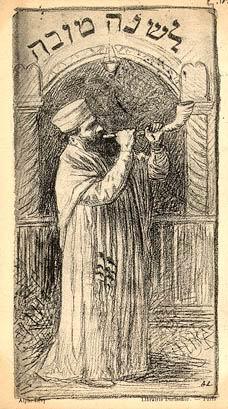Shofar
Shofar is an ancient musical horn typically made from a ram's horn, used for Jewish religious purposes. The shofar is most prominently associated with Rosh Hashanah (the Jewish New Year) and Yom Kippur (the Day of Atonement), two of the most sacred days in the Jewish calendar. Its sound is meant to awaken the listeners from their slumbers and alert them to the coming judgment.
Origins and History[edit | edit source]
The origins of the shofar can be traced back to biblical times, with its first mentioned use in the Book of Exodus during the revelation at Mount Sinai. The shofar was sounded to announce the presence of God and to gather the Israelites together. Over the centuries, its use has been codified within Jewish law (Halakha) and tradition. The shofar is also mentioned in connection with the Jubilee year, in which it was used to signal the release of slaves and the return of lands.
Design and Sound[edit | edit source]
A shofar is made from the horn of a ram or other kosher animals, excluding bovine species. The process of making a shofar involves cleaning, shaping, and sometimes polishing the horn. It has a distinctive sound that varies depending on its size, shape, and the skill of the blower. There are three primary sounds made by the shofar: Tekiah, a long single blast; Shevarim, a series of three short blasts; and Teruah, a rapid series of nine staccato notes.
Religious Significance[edit | edit source]
The shofar holds profound religious significance in Judaism. It is a symbol of repentance, freedom, and the spiritual renewal that comes with the New Year. The sounding of the shofar on Rosh Hashanah is a commandment (mitzvah), and it is also blown at the conclusion of Yom Kippur, marking the end of the fast and the sealing of the Book of Life. In addition, the shofar is associated with the Messiah's coming and the future redemption of the Jewish people.
Contemporary Use[edit | edit source]
Today, the shofar continues to be an integral part of Jewish religious ceremonies, particularly during the High Holy Days of Rosh Hashanah and Yom Kippur. It is also used in some modern Jewish wedding ceremonies and other religious events. The sound of the shofar, with its deep, resonant tones, serves as a powerful call to reflection, repentance, and renewal for Jews around the world.
See Also[edit | edit source]
Navigation: Wellness - Encyclopedia - Health topics - Disease Index - Drugs - World Directory - Gray's Anatomy - Keto diet - Recipes
Search WikiMD
Ad.Tired of being Overweight? Try W8MD's physician weight loss program.
Semaglutide (Ozempic / Wegovy and Tirzepatide (Mounjaro) available.
Advertise on WikiMD
WikiMD is not a substitute for professional medical advice. See full disclaimer.
Credits:Most images are courtesy of Wikimedia commons, and templates Wikipedia, licensed under CC BY SA or similar.
Contributors: Prab R. Tumpati, MD






